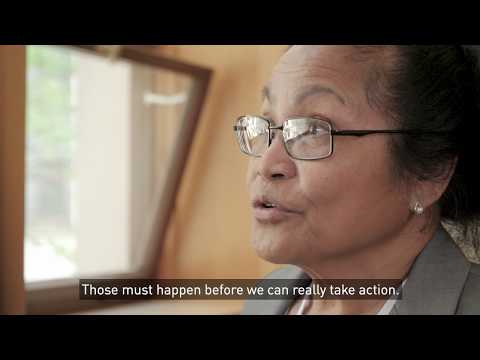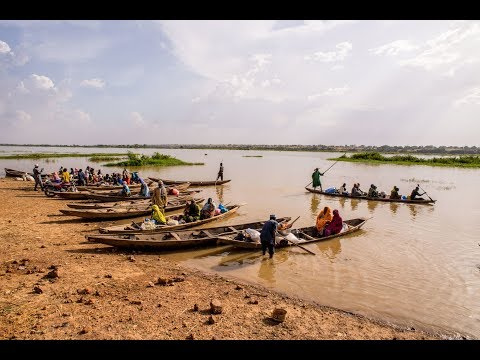Climate & Peace
Climate and security at the United Nations
The impacts of climate change undermine livelihoods and critical aspects of stability such as access to food and water.
These impacts can exacerbate drivers of conflict including displacement and resource competition. The global climate crisis is, therefore, a key risk to international peace and stability.
While the United Nations (UN) system needs to act as a whole to reduce these risks, the UN Security Council (UNSC) has the primary responsibility for maintaining international peace and security.
The UNSC can help reduce climate-security risks by ensuring that climate change and related security challenges are reflected across all UN activities that address conflict — from prevention to restoring peace.
By providing political guidance through its mandates, the UNSC can support Member States and institutions around the globe in better addressing climate-security risks.

How can UN organs respond to climate-security risks?
The entire UN system can help sustain peace by addressing climate-related security risks throughout the conflict cycle, notably:
- Conflict prevention, peacebuilding and mediation always need to consider climate change impacts. There will be no durable peace, if people are not able to secure nature-dependent livelihoods in a changing climate.
- Low-carbon development and adaptation initiatives need to ensure they do not cause or exacerbate conflict.
The UN Security Council can help ensure that climate change and related security challenges are reflected across all UN activities that address conflict — from prevention to restoring peace.
You can find specific entry points for the UN Security Council and other UN organs to address climate-security risks in this policy paper provided by the Climate Security Expert Network.


Building resilience on the ground

The question is no longer whether humanity will experience negative climate impacts, but how and when.
We must pursue the goals of ensuring global peace and prosperity through this lens: societies need resilience.
Resilience requires a holistic approach to adaptation and peacebuilding. 70 percent of the countries most vulnerable to climate change are also among the most fragile.
There is a clear need to address climate and conflict risks simultaneously.
Afghanistan: Double vulnerability

The people of Afghanistan have endured nearly constant armed conflict for the past 40 years. Increasingly, their towering glaciers, vast rangelands, and life-giving rivers are under threat as well. The country has already warmed by 1.8 degrees Celsius since 1950, far more than the global average.
Climate change undermines the prospects for peace in Afghanistan in many ways. More frequent droughts could boost the drug economy by encouraging farmers to plant poppy, a drought-resistant plant. Scarcer water and arable land could increase competition among groups who rely on livestock herding and rain-fed farming, fuelling conflict along community and ethnic lines. International tensions over water resources could undermine efforts to stabilise the country.
Afghanistan already struggles to provide services to the entire population, and it is ill equipped to deal with the effects of natural disasters, forced displacement and bad harvests. However, the Afghan government has begun to integrate climate throughout its policy-making.
By continuing this approach and improving land and water management in particular, Afghanistan can prepare itself for the climate impacts to come. Moreover, jointly addressing environmental issues might help build confidence in the Afghan peace process. The international community can and should support this. The UN Security Council should provide political leadership by including appropriate guidance into its mandates for UN assistance missions.
Terrorism is not going to linger here forever, but climate change is an ongoing death sentence.
For more insights, consult the climate-fragility risk brief on Afghanistan provided by the Climate Security Expert Network.

Pacific islands: Small states in great danger
The ultimate security threat to any nation is its disappearance — and some Pacific islands could literally be swallowed up by the ocean as sea levels rise. Yet climate change also presents many other security threats that have received comparatively little attention.
Even moderate sea level rise will cause displacement due to salinisation. Increases in temperature and rainfall could trigger outbreaks of water-borne diseases such as malaria. Food security is under threat, too. Tuna catches are expected to decline by 20 percent under a high emissions scenario. Declining revenues from fishing are a major economic problem in a region highly dependent on maritime resources.
These climate impacts are likely to increase tensions in the region. The disappearance of low-lying land risks spurring disputes over maritime boundaries and fishing rights, both among island nations and between them and outside powers. In addition, forced migration is likely to undermine traditional land tenure systems.
Small island states need an efficient UN support system. Above all, the international community must secure the very survival of Pacific islands by achieving the goals of the Paris Agreement. It should also help the region to boost adaptation and resilience to climatic changes already underway. For example, the international community can contribute to regional data collection; bolster monitoring and early warning systems, and support vulnerability assessments and displacement planning.
No man is an island; no island should stand alone.
For more insights, consult the climate-fragility risk brief on the Pacific Islands Region provided by the Climate Security Expert Network.
We reaffirm that climate change remains the single greatest threat to the livelihoods, security and wellbeing of the peoples of the Pacific.
Why small states must sit at the negotiation table
Lake Chad: Breaking the conflict trap
Climate change contributes to the drivers of conflict, and conflict affects people's adaptation capacities.

Since 2009, Lake Chad has been caught in a conflict trap. Climate change is making the search for ways out even more challenging. Having lived off Lake Chad’s abundance for centuries, fishers, farmers and herders were able to adapt to the lake changing in size with the seasons. But the climate crisis makes rainfall unpredictable. The residents cannot count on using freshwater, grazing lands, fish stocks, and vegetation as they used to, and armed groups and government-imposed travel bans further restrict access to these resources.
Violence between armed opposition groups and state security forces has left 10.7 million people in need of humanitarian assistance. Years of conflict, poverty and human rights violations have eroded relations between generations, ethnic groups, and the displaced and their host communities. Competition for natural resources further increases tensions and the risk of violence.
Military interventions have stabilised some parts of the region. But these, often heavy-handed, responses do not always factor in people’s everyday needs — such as their ability to access land and water in the face of a changing climate. In the past, the military has destroyed crops and banned fishing in efforts to weaken armed opposition groups. However, with options for work increasingly limited, the risk of people turning to these groups rose.
Climate and conflict risks are feeding into each other. If they are to break this vicious cycle, development, humanitarian, stabilisation and peacebuilding efforts need to address climate impacts and conflict challenges at the same time.
Governments could help rebuild fractured social bonds by improving social services, providing climate-sensitive jobs and redressing political marginalisation. Better integrating civilians into planning military interventions could safeguard livelihoods and vital access to natural resources.
International actors should conduct climate and conflict-informed risk assessments to ensure that they understand the potential impacts of humanitarian, peacebuilding and development work on climate and fragility dynamics.
Consult Shoring Up Stability: Addressing Climate & Fragility Risks in the Lake Chad Region, read MOHAMED'S STORY and look at more photos, maps and infographics to understand how climate and fragility interact in the Lake Chad Basin.

Climate change - a critical factor in Lake Chad crisis conflict trap



